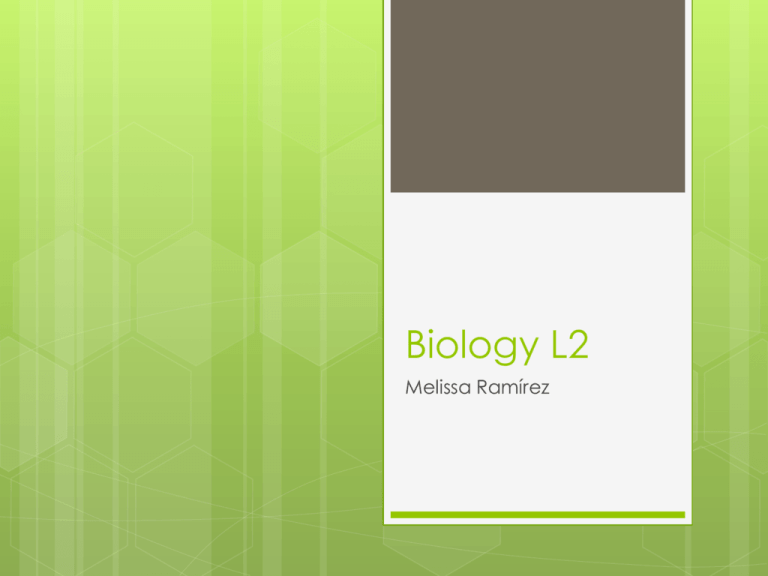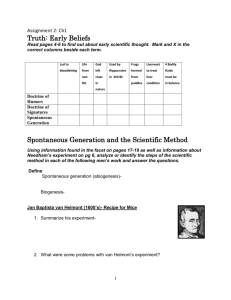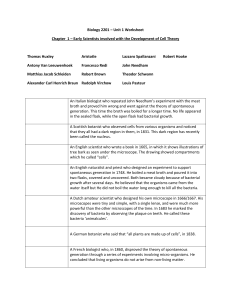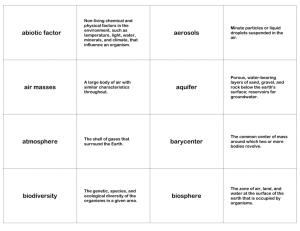File
advertisement

Biology L2 Melissa Ramírez Life on Earth Life! It's everywhere on Earth; you can find living organisms from the poles to the equator, from the bottom of the sea to several miles in the air, from freezing waters to dry valleys to undersea thermal vents to groundwater thousands of feet below the Earth's surface. Over the last 3.7 billion years or so, living organisms on the Earth have diversified and adapted to almost every environment imaginable. The diversity of life is truly amazing, but all living organisms do share certain similarities Theories on Origin of life Theory of Special Creation Theory of Spontaneous Generation Theory of Catastrophism Cosmozoic Theory (Theory of Panspermia) Theory of Chemical Evolution Theory of Special Creation According to this theory, all the different forms of life that occur today on planet earth, have been created by God, the almighty. This idea is found in the ancient scriptures of almost every religion. According to Hindu mythology, Lord Brahma, the God of Creation, created the living world in accordance to his wish. According to the Christian belief, God created this universe, plants, animals and human beings in about six natural days. The Sikh mythology says that all forms of life including human beings came into being with a single word of God. Special creation theory believes that the things have not undergone any significant change since their creation. The theory of Special Creation was purely a religious concept, acceptable only on the basis of faith. It has no scientific basis. Theory of Sponteanous Generation This theory assumed that living organisms could arise suddenly and spontaneously from any kind of non-living matter. One of the firm believers in spontaneous generation was Aristotle, the Greek philosopher (384-322 BC). Continued… He believed that dead leaves falling from a tree into a pond would transform into fishes and those falling on soil would transform into worms and insects. He also held that some insects develop from morning dew and rotting manure. Egyptians believed that mud of the Nile river could spontaneously give rise to many forms of life. The idea of spontaneous generation was popular almost till seventeenth century. Many scientists like Descartes, Galileo and Helmont supported this idea. In fact, Von Helmont went to the extent stating that he had prepared a 'soup' from which he could spontaneously generate rats! The 'soup' consisted of a dirty cloth soaked in water with a handful of wheat grains. Helmont stated that if human sweat is added as an 'active principle' to this, in just 17 days, it could generate rats! Theory of Catastrophism It is simply a modification of the theory of Special Creation. It states that there have been several creations of life by God, each preceded by a catastrophe resulting from some kind of geological disturbance. According to this theory, since each catastrophe completely destroyed the existing life, each new creation consisted of life form different from that of previous ones. Cosmozoic Theory (Theory of Panspermia) According to this theory, life has reached this planet Earth from other heavenly bodies such as meteorites, in the form of highly resistance spores of some organisms. This idea was proposed by Richter in 1865 and supported by Arrhenius (1908) and other contemporary scientists. The theory did not gain any support. This theory lacks evidence, hence it was discarded. Theory of Chemical Evolution This theory is also known as Materialistic Theory or Physico-chemical Theory. According this theory, Origin of life on earth is the result of a slow and gradual process of chemical evolution that probably occurred about 3.8 billion years ago. This theory was proposed independently by two scientists A.I.Oparin, a Russian scientist in 1923 and J.B.S Haldane, an English scientist, in 1928. Continued… According to this theory, Spontaneous generation of life, under the present environmental conditions is not possible. Earth's surface and atmosphere during the first billion years of existence, were radically different from that of today's conditions. The primitive earth's atmosphere was a reducing type of atmosphere and not oxidising type. The first life arose from a collection of chemical substances through a progressive series of chemical reactions. Solar radiation, heat radiated by earth and lighting must have been the chief energy source for these chemical reactions.






